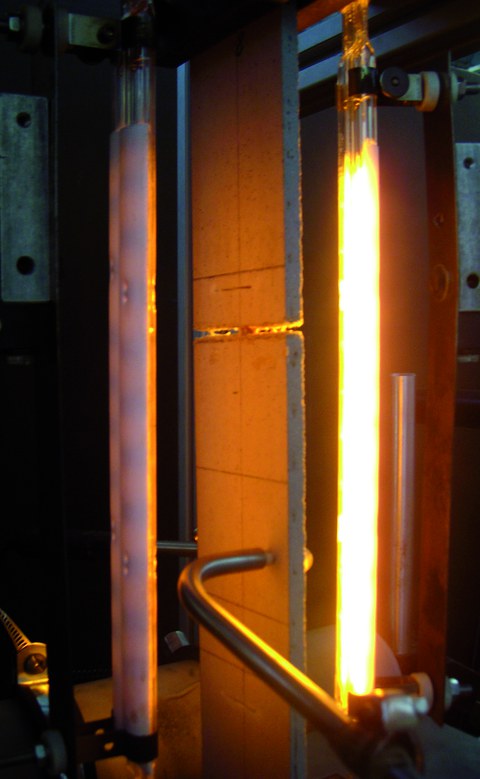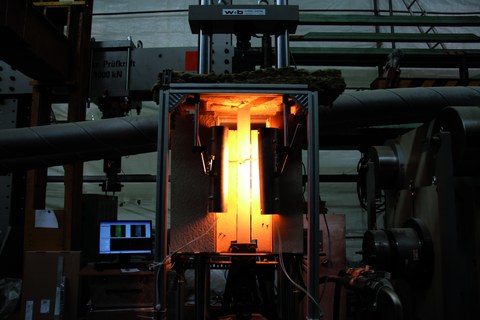CRC 528-D6 (II): Failure mechanism of textile reinforced concrete under fire loading
Table of contents
Project data
|
Titel | Title |
Project website
Report in the yearbook 2010
And it Burns, Burns, Burns

Textile pull-out tests under temperature load
For wide practical use of the innovative strengthening method “textile reinforced concrete” (TRC) information on behaviour of strengthened constructions under fire conditions, especially in consideration of hot measurement according to Eurocode 2, are of high interest.
Different experimental tests on textile concrete components and fabrics were conducted to obtain information on characteristics of textile reinforced concrete under high temperatures. Tests on strengthened reinforced concrete slabs under bending and partial flame impingement conduced to determine temperature profiles, deformations and bearing load capacities. From strain specimen tests at specimen temperatures up to 600 °C we got stress-strain curves and details about the different strain portions. Pull-Out tests under temperature load showed the effect on bond between filament yarn and fine concrete matrix and thus gave information about necessary anchoring and overlap length. Using thermal gravimetric analyses of textile reinforcement under different atmospheric conditions findings regarding loss of weight at the high temperature range could be attained.
All of these tests provided information about the influence of heating on the load bearing behaviour of the TRC layer in dependence on heating rate as well as static load. These results can be accounted for hot measurement of strengthened components, as now the interaction between steel reinforcement and textile carbon fiber reinforcement during fire is understood better.
It could be demonstrated that the behaviour of reinforced concrete components strengthened with textile concrete under fire conditions is dependent on temperature-sensitive force redistribution from steel reinforcement to textile reinforcement. Furthermore the temperature behaviour of coating of the textiles and concentration of oxygen are relevant, because carbon oxidation starts at approx. 500 °C and causes a strength reducing loss of the cross-section.
Report in the yearbook 2009
Textile Reinforced Concrete Under Fire

Tension test on a strain specimen under temperature load
One area of use for textile reinforced concrete (TRC) strengthening is in existing reinforced concrete structures. Until now, there have been no reliable conclusions drawn about the behavior of TRC layers or the load distribution that occurs between the concrete steel rebar and textile reinforcement during fire. Details concerning the high temperature properties of concrete and reinforcing steel can be gathered from literature. The behavior of applied carbon fibers under high temperature loads, as well as the bond between the textile reinforcement and fine concrete matrix, needs to be analyzed experimentally.
TRC Strengthened RC Slabs
Within the context of experimental research, RC slabs were strengthened with various types of textile reinforcement and then pre-damaged, by applying 125 % of the service load, and subsequently charged with a fire load in accordance with the cellulosic curve (ISO-834) (i.e., under service load). All slabs resisted fire loading with simultaneous bending forces for more than 60 minutes; furthermore, there was neither concrete spalling nor any other observable deterioration present. The mechanisms which can be attributed to this behavior, although not yet entirely understood, are discussed, nonetheless. The varying thermal properties of the steel, concrete, textile and bond components within the specimens and related load redistribution within the crosssection, as well as the specific cracking behavior of TRC, presumably, play a key role in the surprisingly positive results. Subsequently identified residual load bearing capacities are 96 to 166 % of the service load and 47 to 88 % of the ultimate load.
TRC Strain Specimens
Tension tests on strain specimens under temperature load were utilized to determine mechanical and thermal properties of TRC at high temperature. Temperature-time-functions, measured at the strengthening layer of RC strengthened slabs, are used for the temperature course of fire tests. These pre-determined values are based on the guidelines for heating design according to Eurocode 2, Part 1-2. Deformation was measured using photogrammetry so as to avoid contact with the specimen (i.e., for experimental control).
Distinct differences were attained, as follows, by varying end conditions: Stationary tensile creep tests were conducted in which various heating rates were applied to the specimens until the desired temperature was reached. Spalling of the fine concrete matrix occurred only at the highest heating rate of 10 K/min at approx. 140 °C. These displacement-controlled tensile tests resulted in stress-strain-curves, ultimate strains and Young`s moduli for a variety of temperatures. Load capacity began to decrease at 400 °C and continued to drop until failure under unstationary creep tests with both a constant stress level and heating rate.
